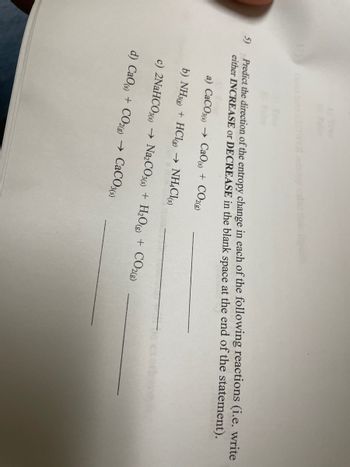
Chemistry
10th Edition
ISBN: 9781305957404
Author: Steven S. Zumdahl, Susan A. Zumdahl, Donald J. DeCoste
Publisher: Cengage Learning
expand_more
expand_more
format_list_bulleted
Question

Transcribed Image Text:FR entropy
5)
Predict the direction of the entropy change in each of the following reactions (i.e. write
either INCREASE or DECREASE in the blank space at the end of the statement).
a) CaCO3(s)→ CaO (s) + CO2(g)
b) NH3(g) + HCl(g) → NH4Cl(s)
exoth
c) 2NaHCO3(s) → Na₂CO3(s) + H₂O(g) + CO2(g)
d) CaO (s) + CO2(g) → CaCO3(s)
Expert Solution
This question has been solved!
Explore an expertly crafted, step-by-step solution for a thorough understanding of key concepts.
This is a popular solution
Trending nowThis is a popular solution!
Step by stepSolved in 2 steps with 1 images

Knowledge Booster
Learn more about
Need a deep-dive on the concept behind this application? Look no further. Learn more about this topic, chemistry and related others by exploring similar questions and additional content below.Similar questions
- Predict the sign of ΔSorxn (positive or negative) for the following reactions: isopropanol condenses sodium chloride dissolves in pure water 2 NH3(g) + CO2(g) → NH2CONH2(aq) + H2O(l) I2(g, 200 oC) → I2(g, 300 oC)arrow_forwardConsider the evaporation of methanol at 25.0 ∘C: CH3OH(l)→CH3OH(g). a) PCH3OH=154.0mmHg Express the free energy change in kilojoules to one decimal place. (ΔG∘) b) PCH3OH=106.0mmHg Express the free energy change in kilojoules to one decimal place. (ΔG∘) c) PCH3OH=11.00mmHg Express the free energy change in kilojoules to one decimal place. (ΔG∘)arrow_forwardMethanol is relatively inexpensive to produce. Much consideration has been given to using it as a precursor to other fuels such as methane, which could be obtained by the decomposition of the alcohol. CH3OH(l) -> CH4(g) + 1/2 O2(g) (a) What are the sign and magnitude of the entropy change for the reaction? Does the sign of Δarrow_forward
- For each of the following reactions determine if the change in entropy was positive or negative:A) Water at 40°C → Water at 25°CB) 2NO2(g) → N2O4(g)C) CH3OH (l) → CH3OH (g)D) PbCl2(s) → PbCl2(aq)arrow_forwardWhat is the change in entropy, AS, for the following reaction? Use Table G in your book for values of standard entropies. Your answer should be in J/K mol. CaCO3(s) + 2 H'(aq) → → Ca² (aq) + H₂O(l) + CO2(g) O 264.9 J/K mol O 118.6 J/K mol 394.3 J/K mol 137.7 J/K mol 2arrow_forwardUsing enthalpies of formation, calculate deltaH for the following reaction at 25°C. Also calculate deltaS for this reaction from standard entropies at 25°C. Use these values to calculate deltaG for the reaction at this temperature. Species deltaHf(kJ/mol) S(J/mol⋅K) CH3OH(l) –238.7 126.8 O2(g) 0 205.0 CO2(g) –393.5 213.7 H2O(l) –285.8 69.95 2CH3OH(l) +3O2(g) --- 2CO2(g) + 4H2O(l) deltaH = kJ deltaS = J/K deltaG = kJarrow_forward
- Use the data to calculate the standard entropy change for the following reaction: 5. S°[Mt(s)] 43.2 J/K mol Mt(s) + ½ O2(g) → MtO(s) S°[O2(g)] = 305.1 J/K-mol S°[MtO(s)] 62.6 J/K mol a) -133.2 J/K b) -285.7 J/K c) 285.7 J/K d) 133.2 J/Karrow_forwardAG (ky/mol) SUbStance / 1on so (ky/mol) -1206.9 /moi k) 92.9 • CaC03l>) -|128.8 • CaO (s) |- 635. I – 60 3.5 38.2 • CO2(9) - 393.5 - 394.4 213.7 191.5 3 H2(g) 202.7 ZNH3 ) -45.9 -16 193 • Hz (g) 202.7 223.0 -92.31 - 95. 30 186.79arrow_forwardlist any physical changes you can think of in which entropy increases (ΔS = +)arrow_forward
arrow_back_ios
arrow_forward_ios
Recommended textbooks for you
 ChemistryChemistryISBN:9781305957404Author:Steven S. Zumdahl, Susan A. Zumdahl, Donald J. DeCostePublisher:Cengage Learning
ChemistryChemistryISBN:9781305957404Author:Steven S. Zumdahl, Susan A. Zumdahl, Donald J. DeCostePublisher:Cengage Learning ChemistryChemistryISBN:9781259911156Author:Raymond Chang Dr., Jason Overby ProfessorPublisher:McGraw-Hill Education
ChemistryChemistryISBN:9781259911156Author:Raymond Chang Dr., Jason Overby ProfessorPublisher:McGraw-Hill Education Principles of Instrumental AnalysisChemistryISBN:9781305577213Author:Douglas A. Skoog, F. James Holler, Stanley R. CrouchPublisher:Cengage Learning
Principles of Instrumental AnalysisChemistryISBN:9781305577213Author:Douglas A. Skoog, F. James Holler, Stanley R. CrouchPublisher:Cengage Learning Organic ChemistryChemistryISBN:9780078021558Author:Janice Gorzynski Smith Dr.Publisher:McGraw-Hill Education
Organic ChemistryChemistryISBN:9780078021558Author:Janice Gorzynski Smith Dr.Publisher:McGraw-Hill Education Chemistry: Principles and ReactionsChemistryISBN:9781305079373Author:William L. Masterton, Cecile N. HurleyPublisher:Cengage Learning
Chemistry: Principles and ReactionsChemistryISBN:9781305079373Author:William L. Masterton, Cecile N. HurleyPublisher:Cengage Learning Elementary Principles of Chemical Processes, Bind...ChemistryISBN:9781118431221Author:Richard M. Felder, Ronald W. Rousseau, Lisa G. BullardPublisher:WILEY
Elementary Principles of Chemical Processes, Bind...ChemistryISBN:9781118431221Author:Richard M. Felder, Ronald W. Rousseau, Lisa G. BullardPublisher:WILEY

Chemistry
Chemistry
ISBN:9781305957404
Author:Steven S. Zumdahl, Susan A. Zumdahl, Donald J. DeCoste
Publisher:Cengage Learning

Chemistry
Chemistry
ISBN:9781259911156
Author:Raymond Chang Dr., Jason Overby Professor
Publisher:McGraw-Hill Education

Principles of Instrumental Analysis
Chemistry
ISBN:9781305577213
Author:Douglas A. Skoog, F. James Holler, Stanley R. Crouch
Publisher:Cengage Learning

Organic Chemistry
Chemistry
ISBN:9780078021558
Author:Janice Gorzynski Smith Dr.
Publisher:McGraw-Hill Education

Chemistry: Principles and Reactions
Chemistry
ISBN:9781305079373
Author:William L. Masterton, Cecile N. Hurley
Publisher:Cengage Learning

Elementary Principles of Chemical Processes, Bind...
Chemistry
ISBN:9781118431221
Author:Richard M. Felder, Ronald W. Rousseau, Lisa G. Bullard
Publisher:WILEY